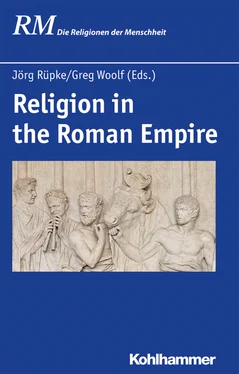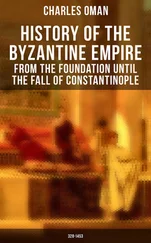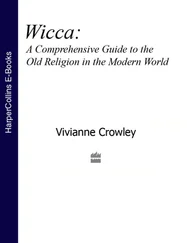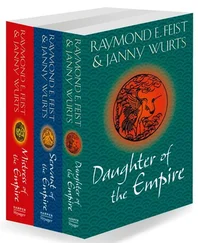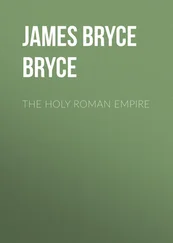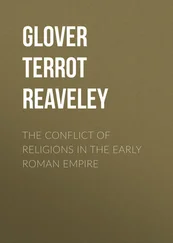Die Religionen der Menschheit
Begründet vonChristel Matthias Schröder
Fortgeführt und herausgegeben von
Peter Antes, Manfred Hutter, Jörg Rüpke und Bettina Schmidt
Band Band 16,2
Preparation of an animal sacrifice; marble, fragment of an architectural relief, first quarter of the 2nd century CE. Department of Greek, Etruscan and Roman Antiquities, Rome, Italy.
Jörg Rüpke, Greg Woolf (Eds.)
Religion in the Roman Empire
Verlag W. Kohlhammer
Alle Rechte vorbehalten
© W. Kohlhammer GmbH, Stuttgart
Gesamtherstellung: W. Kohlhammer GmbH, Stuttgart
Print:
ISBN 978-3-17-029224-6
E-Book-Formate:
pdf: ISBN 978-3-17-029225-3
epub: ISBN 978-3-17-029226-0
All rights reserved. This book or parts thereof may not be reproduced in any form, stored in any retrieval system, or transmitted in any form by any means—electronic, mechanical, photocopy, recording, microfilm/microfiche or otherwise—without prior written permission of W. Kohlhammer GmbH, Stuttgart, Germany.
Any links in this book do not constitute an endorsement or an approval of any of the services or opinions of the corporation or organization or individual. W. Kohlhammer GmbH bears no responsibility for the accuracy, legality or content of the external site or for that of subsequent links.
The Roman Empire was home to a fascinating variety of different cults and religions. Its enormous extent, the absence of a precisely definable state religion and constant exchanges with the religions and cults of conquered peoples and of neighbouring cultures resulted in a multifaceted diversity of religious convictions and practices.
This volume provides a compelling view of central aspects of cult and religion in the Roman Empire, among them the distinction between public and private cult, the complex interrelations between different religious traditions, their mutually entangled developments and expansions, and the diversity of regional differences, rituals, religious texts and artefacts.
Prof. Dr. Jörg Rüpke teaches Religious Studies at Erfurt.
Prof. Greg Woolf teaches Ancient History at the University of California, Los Angeles.
Introduction: Living Roman Religion
Jörg Rüpke and Greg Woolf
1 Approaching Roman Religion
2 The Idea of Religion
3 Lived Ancient Religion
4 The Story of Rome
5 Themes and Methods
Bibliography
Empire as a field of religious action
Greg Woolf and Miguel John Versluys
1 A Religion of the Empire?
2 Emperors in the Religious life of the Roman World
3 Empire as an interaction sphere
4 The Empire in the World
5 Empire and Religions
Bibliography
The City as a Field of Religious Action: Manufacturing the Divine in Pompeii
William Van Andringa
1 A city full of gods
2 The Gods in Action
3 Working with the Gods
4 Conclusion
Bibliography
Sanctuaries – places of communication, knowledge and memory in Roman religion
Rubina Raja and Anna-Katharina Rieger
1 Sanctuaries – places for people and gods
2 The role of sanctuaries in an empire full of differences
2.1 New temples and gods under new rulers
2.2 Villages, towns and regions: spatial-religious references and regional traditions in sanctuaries
2.3 Sanctuaries as places of permanence, political appropriation and religious change
3 Costs, events and experiences: Visitors, users and religious specialists in a sanctuary
3.1 Space for experience—personal needs and religious experience
3.2 Oracles, healing and life counselling
3.3 Great feasts and great gifts
4 Collection of knowledge and objects – sanctuaries in the dynamic between memory and oblivion
Bibliography
People and Competencies
Georgia Petridou and Jörg Rüpke
1 Introduction
2 Public priests
3 Divination, diviners and the diagnostic value of signs
4 Oracular officials in the Eastern Roman Provinces
5 Anchoring religious innovation
6 Small-group religious entrepreneurs
7 Developing a priestly role in Christ-centred imaginations
8 The philosophers as religious experts and henotheistic tendencies before Christianity
9 Setting borders to religious experts
Bibliography
The Gods and Other Divine Beings
Heidi Wendt
1 Introduction
2 The Gods and Roman ›Religion‹
3 Whose Roman Religion?
4 Interacting with Divine Beings in the Roman World
5 Intellectualizing Religious Experts
Bibliography
Managing problems: Choices and solutions
Richard Gordon
1 Introduction
2 Mainstream options
2.1 Healing waters, therapeutic dreams
2.2 Divinatory shrines
2.2.1 Oracles, mainly in Italy
2.2.2 The eastern Mediterranean
2.3 Settling the dead
2.3.1 Monumentum and sepulcrum
2.3.2 Ritual meals
3 Minor ritual specialists
4 Self-help
5 Conclusion
Bibliography
Artefacts and their humans: Materialising the history of religion in the Roman world
Miguel John Versluys and Greg Woolf
1 Introduction: From (Late) Prehistoric to Roman
2 Artefacts and religious change in the Roman world
3 Objects, affordances, and religion
4 Objectscape and semiotic form
5 How new objects and materials change religious practices:
6 Religion in the Empire of things
7 Beyond wood
8 With terracotta (and double moulds)
9 Through marble and
10 Led by lead
11 Conclusion
Bibliography
The Impact of Textual Production on the Organisation and Proliferation of Religious Knowledge in the Roman Empire
Georgia Petridou and Jörg Rüpke
1 Introduction
2 Calendars: Appropriating Time and Systematizing Religious Action
3 Controlling ›Religion‹: Legalization and Ratification of Religious Knowledge
4 Re-framing ›Religion‹: Exegesis, Appropriation and Translation as Means of Reiterating Old and Propagating New Religious Ideas
5 Texts and Rituals in the Second Century CE: A Century of Intense Religious Experimentation
6 ›Religion‹ as Philosophy in the Second Sophistic
7 Martyrologies: Textualizing Death and Embodying
Bibliography
Economy and Religion
Richard Gordon, Rubina Raja and Anna-Katharina Rieger
1 Introduction
1.1 The wider context: the demography and macro-economy of the Roman Empire
1.2 Implications for expenditure on religious activity
2 Income, outgoings and the nature of the evidence
3 Public versus private: an unhelpful opposition?
4 Funding civic and imperial religion
4.1 Standing revenues of sanctuaries and their protection
4.2 Revenues from sacrifice
4.3 Regular income from non-agricultural sources
4.4 Variable income: patronage
4.5 Income versus wealth
5 The finances of associations and small religious groups
6 Pilgrimage as an economic factor
6.1 Competition stimulates business
6.2 Infrastructure and services in and around pilgrimage sites
7 Conclusion
Bibliography
Abbreviations
Figures
Index
Places
Names
Keywords
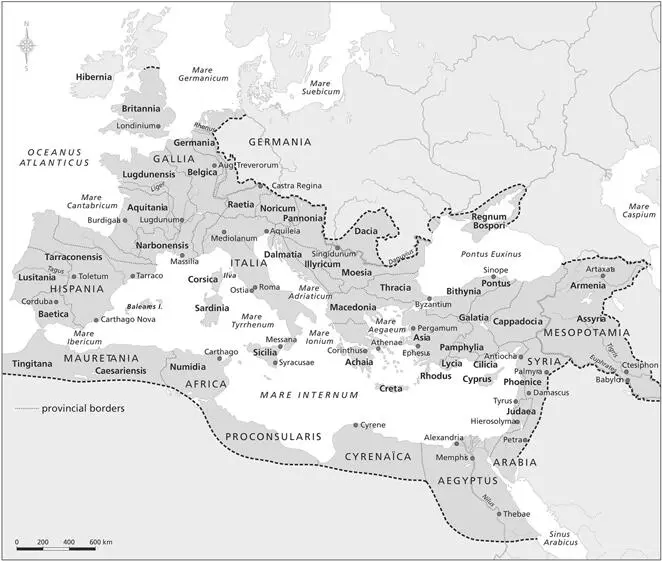
Fig. 1:The Roman Empire 117 A.D.
Introduction: Living Roman Religion
Jörg Rüpke and Greg Woolf
1 Approaching Roman Religion
How can we reconstruct the religious dimensions of life in the Roman empire? How were rituals entangled with the routines of everyday living and extraordinary events? How did relations with the divine intrude into the spaces Roman inhabited and the patterns of their lives? How, in short, was Roman religion lived?
Читать дальше
